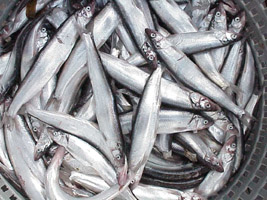

Forage Fish Research
 |
Eulachon (Thaleichthys pacificus).
|
Forage fishes are of particular concern in Alaska because the decline
of these species is considered to be a potential cause of dramatic
declines in populations of
Steller sea lions,
fur seals, and
seabirds
during the past 20 years. Forage fishes are abundant, schooling fishes
preyed upon by many species of seabirds, marine mammals, and other fish
species. They provide important ecosystem functions by transferring
energy from primary or secondary producers to higher trophic levels.
Major forage fishes in Alaska include
juvenile walleye pollock, Pacific herring, Pacific sand lance, capelin, eulachon, and
Atka mackerel. Other species, such as
Pacific salmon juveniles,
are sometimes important (usually seasonally or locally). The North Pacific
Fishery Management Council has designated a special forage fish
management category to prevent directed fishing on some groups of forage
including: gunnels, lanternfish, sandfish, sandlance, smelts, stichaeids,
and euphausiids.
Most forage fishes are distinguished by schooling behavior,
relatively short life spans, and are locally abundant. Most species have
demersal eggs, but walleye pollock have pelagic eggs which are spawned
in deep water along the continental shelf. Other species spawn in
freshwater streams (e.g., Pacific salmon and eulachon), and some species
spawn in the shallow water along the beach (e.g., capelin, Pacific sand
lance, and Pacific herring.)
- INCARDONA, J. P., M. G. CARLS, H. L. DAY, C. A. SLOAN, J. L. BOLTON, T. K. COLLIER, and N. L. SCHOLZ.
2009. Cardiac arrythmia is the primary response of embryonic Pacific herring exposed to crude oil during weathering. Environ. Sci. Technol. 43:201-207.
- JOHNSON, S. W., J. F. THEDINGA, and K. M. MUNK.
2008. Distribution and use of shallow-water habitats by Pacific sand lances in southeastern Alaska. Trans. Am. Fish. Soc. 137:1455-1463.
- HAY, D. E., K. A. ROSE, J. SCHWEIGERT, and B. A. MEGREY.
2008. Geographic variation in North Pacific herring populations: Pan-Pacific comparisons and implications for climate change impacts. Prog. Oceanogr. 77:233-240.
- ROSE, K. A., B. A. MEGREY, D. HAY, F. WERNER, and J. SCHWEIGERT.
2008. Climate regime effects on Pacific herring growth using coupled nutrient–phytoplankton–zooplankton and bioenergetics models. Trans. Am. Fish. Soc. 137:278-297.
- Pacific Herring (Clupea pallasii) in Lynn Canal, Southeast Alaska: Endangered, Threatened, or Struggling?
By: M. G. CARLS, S. W. JOHNSON, S. D. RICE
Conference: Alaska Marine Science Symposium, Anchorage, AK, Jan 2009
(2009 poster, .pdf, 1.45MB) Online.
- Lynn Canal Pacific Herring: a Member of One Big Meta-population
By: S. WILDES, J. J. VOLLENWEIDER, J. GUYON
Conference: Alaska Marine Science Symposium, Anchorage, AK, Jan 2009
(2009 poster, .pdf, 223KB) Online.
- Related AFSC research program reports and activities: forage fish
- Steller Sea Lion Project Theme: Foraging
- Steller Sea Lion Project Theme: Fish Assessment and Fisheries
- Additional publications, posters, and reports.
|
|